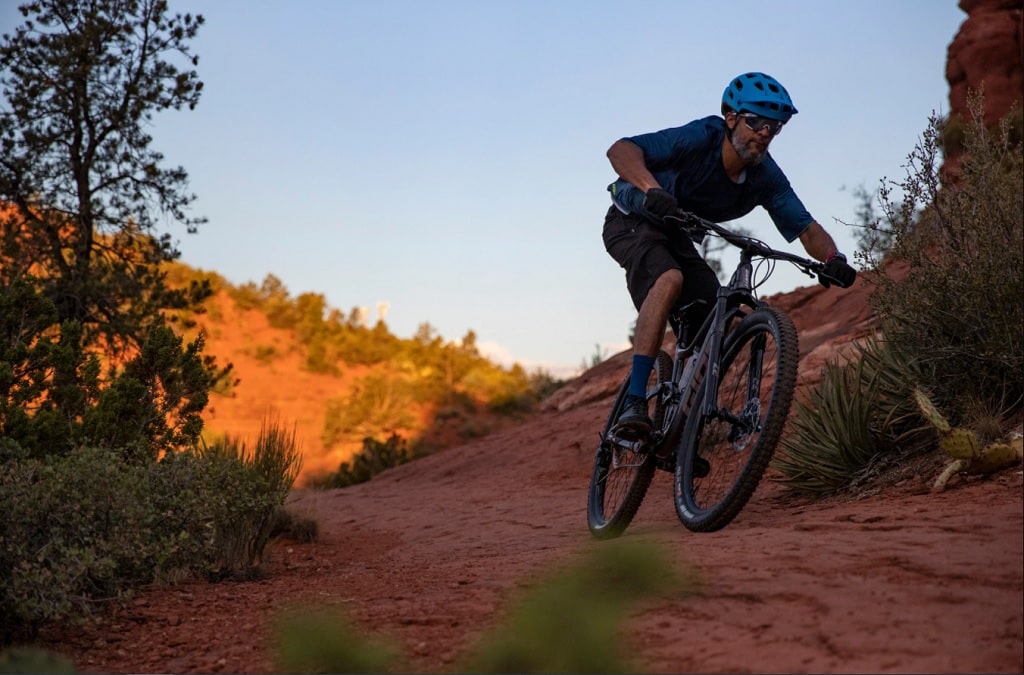Cornering
The few fundamentals that are necessary to apply when approaching a corner and how to position your body when riding the corner on your bike.
MTB Cornering Tips

Using proper cornering technique assist you to maximize safety & performance when you are out mountain biking.
Scan
Constantly scan as far as you can see the trail giving you more time to identify lines, obstacles, and speed.
Corner Type
Identify the type of corner if it’s banked or camber to determine the speed and the line you will take.
Obstacles
Check for obstacles such as roots and stumps to try to avoid. Once you identify a hazard don’t stare at it, if you do you are more likely to hit it, instead forces on the line you will take.
Terrain
Note the type of terrain, such if sand, gravel, leaves, or others, to be aware of the amount of grip that your tires will hold. The more grip you have the tighter and faster you can take the corner.
Arms
Keep your arms bent and loose to assist you in cornering smoothly and to minimize any impacts such as roots, rocks, or other obstacles you might hit.
Legs
The inside leg should be up and the outside leg down. This helps to avoid clipping obstacles and maximize the grip of the mountain bike tire.
Lean
Lean the bike, not your body, so that you keep your stability and center of gravity even but dig the bikes’ tires into the corner.
Torso
Keep low to lower your center of gravity with arms bent, legs bent and torso leaning over.
Pump
Pump into the corner by moving forward and pushing your arms and legs simultaneously down while you move back, this puts more pressure on the tires by compressing the bike and helps it grip into the corner. Keep Reading The 10 Best Mountain Bikes Under $1000 In 2021.
Braking
Ride safer and faster by applying pulse braking and knowing how and when to use your mountain bike brakes.
MTB Braking Tips

If you found yourself blazing downhill on loose terrain heading headfirst into a tree the last thing you want to do is slam on your front brake. Learning to use your brakes correctly when mountain biking helps you ride safer and faster.
Remember these tips and consciously practice them until they become habits.
Pulse
Prolonged braking heats the discs and pretty quickly reduces the stopping power of your brakes. Use pulse braking to keep your brakes cool and perform well from the top of the hill to the bottom.
Trigger
When braking pretend you are pulling the trigger of a gun. This helps you keep control and feel the amount of grip, in the situation, that the tires have and reduces the likely hood of sliding out when over braking.
Simultaneously
The front brake is stronger than the back brake, so for most effective braking use your front and back brakes together.
Wet
Wet brakes don’t brake as well, if your brakes get submerged in water it is a good idea to brake hard on them immediately after to flush out any water that might have got into the mechanism.
Cornering
Brake before corner otherwise if you do it in the corner, you reduce grip on the wheels.
Obstacles
Don’t brake before obstacles, a bit of momentum is better than too little.
Fingers
Use 1 finger for light braking, using two fingers makes it easier if you need to brake harder.
Body Position
Ensure you have an even spread of body position on your bike cause if you are too far forward and your braking hard on your front brake you are more likely to go over the front, or if there isn’t enough weight on the back tire your are more likely to skid.
Focus
Focus ahead and look through the corner to help you keep your lines smooth and prepare for what is ahead. Keep Reading The 10 Best Beginner Mountain Bikes In 2021.
Pedaling
Using the right gear and right actions can lead to improving your speed and stability when you are pedaling along a trail.
MTB Pedaling Tips

Pedaling a bike comes naturally to most people, using the rotation of the front ring the pedal comes up and you push it down with your foot, and the opposite occurs on the other side. When it comes to mountain bike riding in some situations it seems like you are learning to pedal for the first time and knowing how to appropriately apply new techniques to this basic skill can increase you speed, stability, and fun.
Pedals
There are two different types of pedals used on mountain bikes. One type is the flat pedals, which you can wear sports shoes and ride with, and the other kind is clipless, which require specialized biking shoes, that attach the shoe to the pedal. If you are riding with flats your pedaling motion only places momentum on the downward stroke or pushing of the foot, while if you have clipped fewer pedals you will also be pulling up on the stroke with your foot. This is more efficient and one of the reasons cross country riders wear these.
Seat Height
Make sure you set your seat height at the right level. This allows you to maximize your leg muscles on the downward push and nearly fully extends the leg.
Foot
Push down with the ball of your foot on the pedal so that you are transferring the energy efficiency and maintaining a good balance on the pedal, reducing the likely hood of slipping off.
Leg
Try to ensure you keep your leg straight. Many people tend to ‘flick’ their knee out while pedaling and place extra wear and reduce the transfer of energy. While you are pedaling try to imagine a line running from your hip to your foot and keep your feet and knee along with it.
Gearing
Using your gears appropriately helps you maintain balance. Try to keep in low gear when going downhill and higher gear when riding uphill. This will help you prevent your body from bouncing on the saddle when you are in too high of a gear for your speed, and from losing traction on your rear wheel cause you have to stand up to pedal when you are in too low of a gear heading uphill.
I hope you like this article, please share your Ideas and Tips in the comment section. I will update it.
Thank You.

Taylor is an outdoors & sports equipment specialist, sports author, bike traveler, bicycling and skating expert, and smoke-free ride activist. He is also a regular reviewer of outdoor sports gadgets and accessories. About safety gear and biking facts he analyzes and gives his feedback to outdoorxsports. Writes and tests to help him, you, and us.

